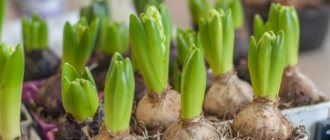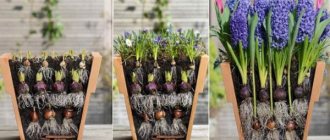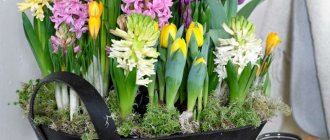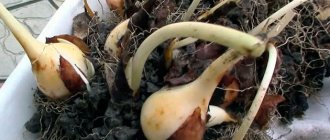Tulips are the most popular spring flowers, which delight with their bright buds with the arrival of the first warmth after winter. Thanks to modern technologies for forcing tulips at home, this spring crop can be grown all year round.
From the article you will learn which varieties of tulips are best suited for forcing, what the process itself is and how to plant correctly in order to grow tulips for the New Year or the beginning of spring.
- Preparing bulbs for planting
Features of an interesting process
Note to flower growers:
- the process takes more than four months;
- Not all varieties are suitable for forcing;
- planting material must be of high quality, large, heavy;
- It is necessary to disinfect the bulbs and substrate to reduce the risk of fungal infections;
- the soil is nutritious, but with good aeration, loose;
- it is important to adjust the temperature at different periods so that sprouts do not appear prematurely;
- after forcing, you can put the bulbs in storage for further germination, if the base has not lost all its juices and is in acceptable condition.
Problems in growing
Droopy leaves must be removed, and it is better to cut off a yellowed plant completely, this will save the bulb from rotting.
If yellow spots are visible on the leaves, nematodes may appear. In this case, diseased bulbs need to be dug up and destroyed before they infect neighboring plants.
Tulip bulbs can become infected with gray mold or fungal disease. It is important not to plant planting material that hints at the presence of fungus.
Pots with bulbs, if they are placed outside, should be brought into a warm place with the first frost. For the winter, the bulbs need to be dug up and stored in the cold. Replace the soil when the time comes for the next planting.
Landing dates
Bulbs are planted at different times: the period depends on the date by which it is important to obtain delicate tulips. Growing spectacular flowers takes about 4.5 months, you need to focus on this figure.
Popular holidays and bulb planting periods:
- February 14 (Valentine's Day, Valentine's Day). Early October.
- February 23 (Men's holiday, Defenders of the Fatherland Day). October 10–12.
- March 8 (Spring Festival, International Women's Day). From 15 to 20 October.
The best option is hardening and rooting of planting material in a cool room, then moving it to a windowsill, heated veranda or room. This method, if the rules of cultivation are followed, gives good results.
When to plant tulips for forcing by March 8: timing
To accurately determine the timing of planting tulip bulbs for forcing, you need to know the characteristics of their growing season. The dormant period of the bulbs lasts 16 weeks. The rooting process and growth of the flower arrow takes an additional 3 weeks.
Thus, it is easy to calculate that the total time from planting to the appearance of buds is 19 weeks. To get flowering plants on March 8, you need to plant them in the last week of October. Using the same principle, planting dates for forcing for other holidays or special dates are calculated.
Varieties of tulips for forcing
When choosing the ideal planting material, you need to take into account an important nuance: exotic flowers with original petal colors are not suitable for home growing. Capricious hybrids do not take root well, and the bulbs often rot. Inexperienced flower growers should not waste money and time experimenting with unusual species: it is easier to take proven, strong planting material, which has many positive reviews.
At home, the following varieties are suitable for forcing tulips from bulbs:
- Parade.
- Aristocrat.
- Eric Hofsier.
- Negrita.
- Diplomat.
- Oxford.
- Lustig Battle.
- London.
Low-growing varieties are an excellent option for growing on a windowsill. It is advisable for novice flower growers to buy planting material at an agricultural store: in this case, the bulbs are already prepared for forcing. Garden plant lovers who want to prepare their own planting material will have to provide their tulips with quality care. This condition is mandatory for the appearance of heavy, strong bulbs. If you are short of time and experience, it is better to buy a base for tulips at a flower shop: weak bulbs are not suitable for growing spectacular specimens on a windowsill.
Technology and step-by-step instructions
Stages:
- selection of the optimal variety;
- purchase of substrate;
- clarification of the number of bulbs for planting;
- selection of optimal containers for forcing tulips;
- identifying rooms with low and moderate temperatures to place flowerpots or wooden boxes with bulbs in the first and second stages of flower forcing;
- purchasing fertilizers and fungicides;
- preparing and planting bulbs;
- caring for the foundation in the soil, watering, adjusting lighting and temperature;
- changing the type of fertilizer depending on the stage: green growth and budding;
- moving boxes or flowerpots into a room with the desired temperature;
- cutting tulips for a holiday or for sale;
- storage of cut materials;
- inspection of the remaining bulbs, sorting the base: dispose of or pickle, put in storage for planting in the ground by the beginning of autumn.
Selection of bulbs and their preparation
Requirements for planting material:
- purchasing from agricultural stores with a good reputation, from well-known companies. You can take underground parts of tulips from your site if the base has gone through a period of cooling and dormancy before planting;
- high-quality bulbs of the highest class;
- preferably Dutch varieties intended for forcing tulips. Information about this feature of planting material is always on the packaging;
- large and heavy: diameter – about 4–5 cm, weight of each – about 30 g;
- varieties resistant to fungal and viral diseases. A dangerous disease often appears on tulips - variegation, which is difficult to combat;
- without damage, rotten areas, cracks, stains or other abnormalities.
Preparation stages:
- remove the covering scales. A simple operation allows you to identify signs of disease and rot on the base. The second positive point: “stripped” bulbs produce roots more actively;
- disinfection is a mandatory procedure. The planting material is etched in a solution of Maxima or Fitosporin preparations. Soaking lasts about half an hour.
On a note! A large, healthy bulb is an important nuance for growing luxurious tulips at home. However, improper care of planting material and failure to comply with the timing of agrotechnical measures, even with ideal bulb quality, negatively affects the result. Before starting such an important process as forcing tulips, you need to study information on the topic and draw up a rough work calendar. A mandatory step is preparing the bulbs for germination, choosing a suitable substrate and container.
Soil and planting capacity
High-quality soil mixture is sold in flower shops. The seller will tell you which substrate is suitable for spring flowers. You can prepare the soil yourself from garden soil (50%), humus (35%) and river sand (15%). The soil should be loose and nutritious. You can add a little peat: about 5%.
Soil disinfection is carried out using:
- potassium permanganate solution (watering the substrate);
- the drug Fitosporin (water the soil);
- Glyokladin tablets (tablets are buried in the ground to a depth of 1.5–2 cm).
Before planting tulip bulbs, it is useful not only to disinfect the soil, but also to fertilize it using nitroamophoska or calcium nitrate. Take 1 tsp for a medium-sized pot. mineral composition.
What should a flowerpot be like when growing spring flowers? When forcing tulips, use a flower pot or wooden box. For three to five bulbs, a medium-sized pot (diameter about 15 cm) is suitable. When growing six or more tulips, you will need a large container or wooden box. Calculating the size of the container is easy: maintain an interval of 2 cm between the bulbs.
Other nuances:
- before planting the bulbs, check that there are several drainage holes in the bottom, otherwise the planting material will quickly begin to rot;
- For placement in one container, approximately the same planting material is chosen;
- It is useful to take a base for tulips of the same variety so that the sprouts appear simultaneously in a certain flowerpot or box.
Planting and rooting
How to proceed:
- prepare the bulbs, fill the containers with soil, water a little with the addition of disinfectants;
- planting material should be buried in the soil, but the top should look out from under the substrate;
- place the cut-off lower part of a plastic bottle on top, a plastic cup, or cover with a plastic bag to maintain high humidity in the mini-greenhouse;
- containers with tulip bulbs for forcing are sent to a room where the temperature is kept at +5 C...+9°C.
Preparing the bulbs
For successful forcing, tulip bulbs must go through a stratification procedure. There are two ways, which we will discuss below.
If you bought already prepared chilled bulbs, then after planting in pots and rooting they do not need to be in the refrigerator or basement - they are immediately placed in room conditions.
Option #1. Long-term cooling 100-130 days
To receive flowers by the desired date, you can calculate the required deadline in advance. How to carry out this stratification:
- The bulbs are sent to the basement or other room with a temperature of about +9 degrees. There should be no sharp fluctuations.
- Humidity in the room is about 75-80%. At the same time, condensation must not accumulate on the bulbs.
Option #2. Short cooling
For this purpose, a special refrigeration chamber is used. The temperature in it should be about +5 degrees. Stratification period is 45 days.
Without exposure to cold, growth and development of the aerial parts and the appearance of buds cannot be achieved.
Rules for care after landing
Only following the recommendations will help you wait until the buds appear. The rules are simple, but scrupulousness is required to maintain optimal conditions when forcing tulips.
Watering
The substrate must always be moist, otherwise rooting is poor. The soil in the flowerpot should not dry out. Watering is carried out every other day, but first check the condition of the soil: water should not stagnate in the substrate. Add liquid from the outside of the plastic container; do not open the onion at an early stage.
Temperature
At the first stage (rooting), minimum temperatures are needed: +5...+9 degrees Celsius. Containers with tulip bulbs are kept in the cellar or on the bottom shelf of the refrigerator. You can take the container out onto a glassed-in balcony or loggia. Indicators cannot be determined by eye: too high or low a temperature disrupts the timing of tulip forcing and can lead to freezing and death of planting material.
After sprouts about 4 cm long appear, the containers are moved to a warmer room: placed on a windowsill or coffee table next to the window. The optimal indicators for germinating tulips during this period are from +15 to +18–19 degrees.
Advice! In the process of growing tulips at home, the temperature is adjusted taking into account the rate of bud formation and green mass gain. If the release and elongation of peduncles is delayed, then the indicators are increased. If growth is too active and there is a high probability of buds forming earlier than the desired date, on the contrary, the temperature is lowered.
Lighting
After germination, flowers need enough light. A window sill on the east side, a balcony or a loggia are suitable areas for placing containers with bulbous plants during the forcing period.
The optimal length of daylight is from 10 to 12 hours. In the autumn-winter period there is no such amount of natural light. What to do? Supplemental illumination of plants compensates for the lack of sunlight.
Humidity
For rooting of bulbs, indicators of 65–70% are needed. A plastic container above the ground retains moisture and allows for less frequent watering. You cannot place boxes and flowerpots with planting material in direct sunlight or near radiators: in such conditions the substrate quickly dries out.
Fertilizers
What type of feeding should I choose? To quickly gain green mass, you need mineral compositions based on nitrogen (ammonium nitrate and urea); when releasing buds, you need potassium sulfate and calcium nitrate.
Many gardeners who force tulips at home believe that fertilizers have less effect on plant development than the size and quality of the bulbs. The reason is simple - it is from the fleshy, large base, and not from the soil, that the young flower takes most of its nutrients.
How to prepare bulbs for planting
To ensure good flowering, you need not only to properly dry and preserve the tulips. It is necessary to properly prepare them, carry out a number of works to increase germination, reduce germination time, and protect them from diseases. Follow these recommendations:
- Carefully inspect and remove all bulbs with signs of disease and damage. If the surface is soft to the touch, also discard such corms. Leave only completely healthy and strong ones.
- Calibrate planting material. For forcing in a short time, select only options with a diameter of 3.5 cm or more. The larger the better, since there are a lot of nutrients, sprouts will appear as soon as possible.
- Be sure to remove children if there are any. If this is not done, then some of the nutrients will be spent on their growth, they will form shoots, and as a result, the buds will grow an order of magnitude smaller. When removing, act carefully so as not to damage the root collar.
- Prepare a solution of potassium permanganate of a deep pink color, do not make it too strong. Instead of potassium permanganate, it is allowed to use Heteroauxin; for this, add half of the tablet to 2 liters of water and stir until it is completely dissolved. Place the bulbs in a disinfectant liquid, leave for 30-40 minutes, then remove and dry on paper or cloth.
If planting material is purchased in a store and processed before planting, then there is no need to specially prepare it. All work has already been done, all that remains is to plant the tulips as described below. Do not soak them for a long time, do not keep them in the solution for more than 40 minutes.
When and how to cut buds
The best timing is selected taking into account the length of time the flowers are stored:
- for the holiday (store for three to four days). The buds must have a specific varietal color without a green tint;
- for sale (storage for one to two weeks). Tulips are cut when the buds begin to show the color characteristic of this variety, and the top is still light green.
Cut flowers are wrapped in paper or newspaper and taken to a cellar or basement: storage is carried out only at low temperatures.
It is useful to give flowers water before and after cutting for sale or making a bouquet for a gift. First, cut the bottom of the stem, then place the specimens in a container with cold water and move them to a cool veranda or other cool area for 24 hours.
Why don't tulips bloom?
There are several reasons:
- low quality planting material;
- bulbs from your garden are not properly prepared for forcing;
- violation of periods of dormancy (low temperatures) and active growth (increased temperature, increased daylight hours);
- rotting of planting material in the absence of treatment of bulbs and soil with disinfectants;
- the florist dug the base for the bulbous plants at the wrong time;
- planting material was stored at too high or low temperatures.
What to do with the bulbs after forcing
First of all, carefully examine the underground part left after cutting the flowers. Most often, the planting material is depleted, devoid of leaves, if the cut was made too low. Such bulbs will have to be disposed of.
Note to flower growers:
- If the base is well preserved and the appearance is quite acceptable, you can use them again, but without proper preparation and storage of new tulips you cannot wait.
- First, the base is soaked in a solution of potassium permanganate (not strong) or etched using fungicides to protect against fungi. The duration of the procedure is from 30 minutes to 1 hour.
- Next, the bulb is dried in air, placed in a box, and put away for storage. The room should be warm enough. The first month the bulbs are kept at a temperature of about +30°C, the second and third - from +22°C to + 23°C, then - at +17°C. The rest of the time (until September) the planting material is kept at a temperature no higher than +5 degrees.
- In a strong onion, a small replacement part is formed inside.
- Planting in the ground is carried out only in September, so that the base of the tulip goes through a dormant period in the cool and the green mass begins to form in the spring. Most often, tulips from preserved bulbs bloom a year later.
Forcing tulips from bulbs requires patience and careful adherence to various aspects of growing spring flowers from the grower. The expenditure of labor and time in most cases is not in vain: for the winter and spring holidays you can please your loved ones with a bouquet of delicate flowers. Not only tulips, but also other bulbous plants are successfully grown on the windowsill: daffodils, hyacinths, snowdrops, crocuses.
How to remove tulips yourself at home? The answer is in the video below:
Which varieties to choose
For the procedure to be successful, you need to choose the right varieties of flowers. Not all of them are suitable for winter growing. In addition, the time by which you want to get flowering plants also plays a role.
For the New Year
Early flowering varieties are suitable for this, as their cooling period is only 16 weeks. These varieties include Apricot Beauty, Christmas Marvel, Diamond Star and others (Figure 2).
Figure 2. Varieties for growing for the New Year: 1 - Apricot Beauty, 2 - Christmas Marvel, 3 - Diamond Star
These same species are also suitable for growing for Christmas, as they have a sufficient flowering time to maintain buds in late December and early January.
By March 8
Crop varieties that can bloom in late February or early March belong to the Darwin hybrid species.
These plants have very diverse petal colors, and the thickness of the stems allows them to be used not only as green decoration, but also for cutting.
Figure 3. Varieties for cultivation by March 8: 1 - Oxford, 2 - Diplomat, 3 - Scarborough, 4 - Vivex
Popular varieties of this type include Oxford, Diplomat, Eric Hofsue, Scarborough, Vivex and others (Figure 3).
By April
Varieties intended for cultivation by April require more care. Firstly, they are exposed to low temperatures longer. And secondly, after this they need to be properly warmed up to activate growth and flowering.
Figure 4. Varieties for cultivation by April: 1 - Ad Rem, 2 - Gordon Cooper, 3 - London, 4 - Parade
The varieties for such cultivation are also quite diverse. Among them are Ad Rem, Gordon Cooper, London, Daydream, Parade and Oxford Elite (Figure 4).
By May
The cultivation of tulips by the beginning of May is carried out mainly using late-flowering varieties. However, subject to certain conditions, other types can be used.
Figure 5. Varieties of tulips for May: 1 - Aristocrat, 2 - Negrita, 3 - Hibernia
The most popular varieties are Aristocrat, Negrita, Parade, Hibernia and others (Figure 5).











